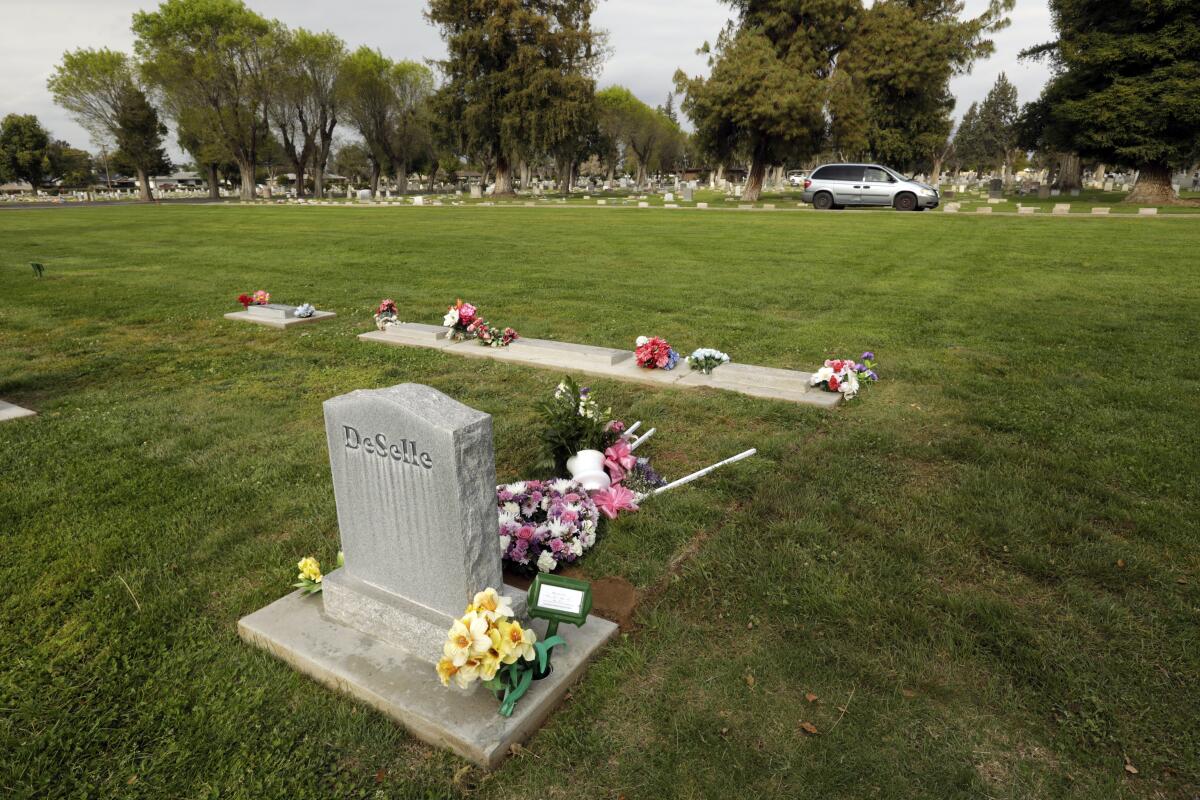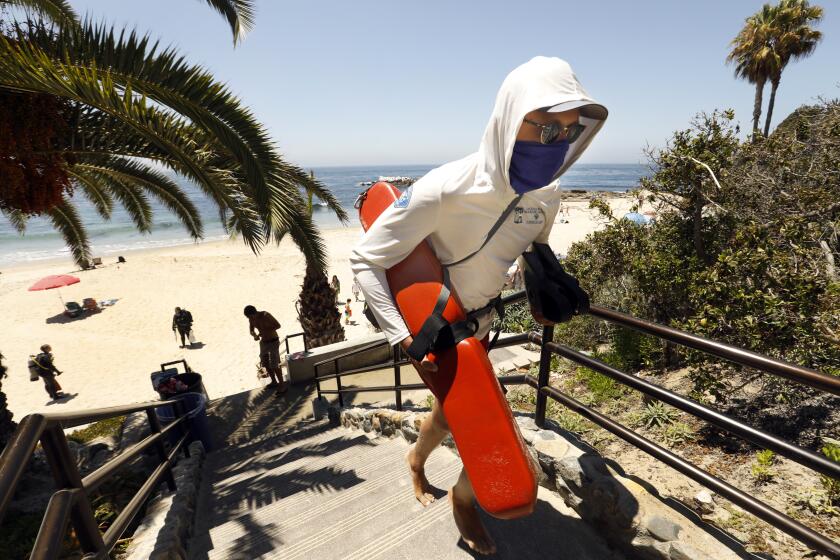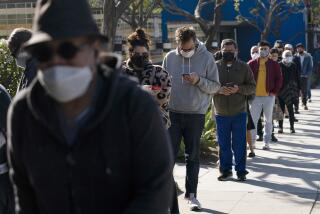With 10,000 COVID-19 deaths, California increasingly in the dark about spread

California has now recorded more than 10,000 deaths from coronavirus.
But the milestone comes at a complex and confusing time in the pandemic. After a two-month surge in cases following the reopening of the economy, there are signs the outbreak is peaking and the rate of infections is going down.
Yet a serious breakdown in the electronic collection of coronavirus test data has raised questions about how accurate the numbers are.
A lot is riding on fixing the system. Schools are debating if and when they can reopen to anything other than remote learning. If counties see a big decline in cases, they could consider reopening some closed businesses and institutions.
Here is what we know from coverage over the last week in The Times:
Where are we with the numbers?
As of Friday morning, there were 541,494 confirmed cases and 10,028 coronavirus-related deaths statewide. California now has more cases than any other state, but the death toll is still well below that of New York, where more than 32,700 have died.
Los Angeles County, which is approaching 5,000 fatalities, has by far the most deaths in California. On Thursday, the county hit another somber milestone, topping 200,000 total cases.
The surge of the virus in California over the last two months has had several causes, including the reopening of the economy that allowed COVID-19 to spread rapidly among low-wage essential workers, many of them Latinos whose employers haven’t followed new infection-control rules.
But summer celebrations among young people are also a recurring problem and one particularly frustrating to officials trying to slow outbreaks.
At fraternity houses and Hollywood mansions, parties that defy public health orders are fueling a coronavirus surge in the young.
What do we know about the dead?
Older people are by far the most likely to die from coronavirus, and nursing homes have been particularly hard hit.
More than 40% of those who have died were older than 80, and more than 20% have been between 70 and 79, according to The Times tracker. But when it comes to confirmed cases, the demographics are skewing much younger. The vast majority of those newly infected are between 18 and 49.
The Times has a running list of tributes to lives lost.
“The Times has spoken with hundreds of people about their loved ones’ lives. Through those difficult conversations, a pattern of human kindness has emerged,” Hayley Smith wrote last week. “Story after story touches on small acts of generosity and great acts of charity — fundraisers, volunteer work, reliable helping hands. As a whole, the tributes tell the stories of ordinary people with ordinary lives who are remembered most for the extraordinary things, large and small, they did for others.”
Are things getting better?
Possibly.
A Los Angeles Times analysis on Monday found that California experienced its first weekly reduction in new confirmed coronavirus cases for the first time in 12 weeks. For the seven-day period that ended Sunday, California reported 59,697 new cases, a drop of 9% from the previous week of 65,634 cases, which was a record.
If the trends continue, it would mark a turning point after weeks of record hospitalizations that began in mid-June, the result of California starting to rapidly reopen the economy in May.
California experienced its highest number of average daily COVID-19 hospitalizations about two weeks ago; for the week of July 20, there were an average of 6,969 people in hospitals statewide. That number fell last week to 6,632. The improvement was the first time in 10 weeks that California has seen such a reduction in average daily hospitalizations.
But the data snafu has cast doubt on whether the picture is actually improving.
Technical glitches with the state’s system for analyzing test results have led to flawed reporting of infection rates.
What do we know about the data issues?
At issue is an electronic system, called CalREDIE, that reports coronavirus test results to the state’s disease registry system. California, as a result, lacks an accurate count of coronavirus infections, leading health officials to freeze the state’s watch list, with no counties being added or removed.
The flawed picture has cast California’s pandemic outlook into serious doubt. On Wednesday, the state counted 5,300 new coronavirus cases, down from a peak of nearly 13,000 reported about two weeks ago. But the steep drop relies on the underreported data, and health officials remain unsure about the actual caseloads.
Dr. Mark Ghaly, California’s Health and Human Services secretary, called the problem his department’s “top priority” and said a team of dozens had been working “around the clock” to make fixes.
“Having accurate data is critical for public confidence, contact tracing and hospital surge planning. We will not rest until this problem is resolved,” Ghaly said in a statement. “All Californians and local public health officials must have accurate data, and we pledge to share a full accounting of when these problems began and their magnitude as soon as we have a clear understanding — and the solutions to address them.”
The California Department of Public Health has directed all laboratories to report positive results directly to county health departments until the problem is resolved. Some county health departments are resorting to counting the tests results by hand to get accurate totals.
The lack of reliable infection rate data has led many counties to add disclaimers on their public health websites saying the information is unreliable. The information also is not being published on the state’s county data monitoring website, according to the California Department of Public Health. The state has not given a timetable for when the problem might be fixed.
“CalREDIE has broken,” said Peter Beilenson, director of Sacramento County’s Department of Health Services. “The bottom line is we don’t know the real caseload. ... We don’t know if we are missing 250 cases [a day] or 50 cases,” he said of his local numbers. “We have no idea.”
Newsom may have relied on faulty numbers when announcing a steep decline in infection rates.
What are the biggest COVID-19 concerns right now?
Recently, coronavirus hot spots have shifted from urban areas to rural ones.
Earlier in the pandemic, Los Angeles County was one of the hot spots for new infections. By June, it was Imperial County. The rural, agricultural and impoverished county east of San Diego soared up the list as California’s hardest hit county, in terms of new cases per 100,000 residents over the past two weeks. Imperial County hit its worst number on June 16, when there were 1,438 cases per 100,000 residents over the previous two weeks.
Now it’s clear that the virus is hitting the Central Valley the hardest. Kern County, home to Bakersfield, has recorded 1,160 cases per 100,000 residents over the past two weeks. The rate reached its highest point Saturday, with 1,376 cases per 100,000 residents over the prior two weeks — more than nine times what it was at the beginning of July, when the county reported 136 cases per 100,000 residents.
The Central Valley is among the areas of the nation that federal officials are particularly worried about. Dr. Anthony Fauci, the U.S. government’s top infectious diseases expert, said the big problem is the uptick in the rate at which coronavirus tests are confirming infections.
The 14-day positive test rate climbed to 24% in Kern County on Monday, more than triple the state’s average of 7% on that day.
“This is a predictor of trouble ahead,” Fauci said Thursday on CNN. A high rate of tests confirming infections is “a clear indication that you are getting an uptick in cases, which inevitably — as we’ve seen in the Southern states — leads to surges, and then you get hospitalizations, and then you get deaths.
“Now is the time to accelerate the fundamental preventive measures ... masks, social distancing, avoiding crowds,” Fauci said.
The region reported more than 27,000 new COVID-19 cases over the last two months. The area now accounts for 19% of new infections, although it comprises just 12% of the countywide population, analysis shows.
If conditions improve, should we expect another round of rapid reopening of businesses?
Not necessarily.
Many experts say the decision to again close bars, indoor dining, shopping malls and other locations for a second time likely helped slow the expansion of the virus.
Gov. Gavin Newsom said Monday the state needs to be cautious.
“We can quickly find ourselves back to where we were just a few weeks ago, a month ago, with significant increases if we do not maintain our vigilance,” Newsom said. “Until we have a vaccine, we are going to be living with this virus.”
One of the things the governor says will be different with a new reopening would be looking not only for consistent stabilization of key pandemic numbers — as occurred before the first reopening — but consistent declines as well. And Newsom said there needs to be greater effort to educate the public about how to reduce the spread of the disease, and that will be “foundational in terms of any subsequent efforts to reopen.”
In the first reopening, too many Californians resumed gatherings and did not wear masks, he said, planting the seeds for a resurgence.
“Let’s not relive that experience again,” Newsom said.
“We didn’t expect people to become complacent as they have, which provides more opportunities for transmission,” added Dr. Robert Kim-Farley, medical epidemiologist and infectious-diseases expert at the UCLA Fielding School of Public Health. “We can’t expect to reopen again soon,”
Times staff writers Alex Wigglesworth, Sean Greene, Iris Lee and Anita Chabria contributed to this report.
More to Read
Start your day right
Sign up for Essential California for news, features and recommendations from the L.A. Times and beyond in your inbox six days a week.
You may occasionally receive promotional content from the Los Angeles Times.













